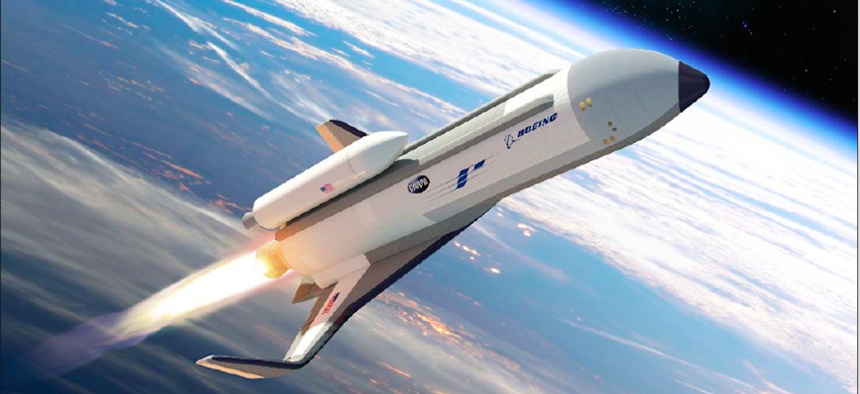
An artist rendering of the XS-1 Spaceplane DARPA
DARPA Picks Boeing To Build Its New Space Plane
The research agency hopes its XS-1 jumpstarts a whole new industry of very-low-cost satellite launches.
Boeing did such a good job plotting out the commercial future of a reusable satellite-launching plane that they’re going to get to build it — and just maybe, launch a whole new low-cost satellite industry.
On Thursday, the Defense Advanced Research Projects Agency, or DARPA, announced that Boeing had won the contract for Phases 2 and 3 of the XS-1 “space plane,” a reusable craft meant to launch 10 satellites in 10 days by 2021 or so, a goal that is key to the future of global military satellite communications.
“We’re very pleased with Boeing’s progress on the XS-1 through Phase 1 of the program and look forward to continuing our close collaboration in this newly funded progression to Phases 2 and 3 — fabrication and flight,” program manager Jess Sponable said in a Thursday press release.
Phase 2 covers the manufacture of the craft and Phase 3 covers final testing: 12 to 15 flights in 2020.
Being able to launch a satellite into low earth orbit every day would be a huge boost to the military. Currently, it costs about $350 million to launch a 1,500- to 3,000-pound satellite, and that’s far less than when the space plane program was originally conceived. By contrast, DARPA hopes the hypersonic XS-1 will do each job for $5 million.
Ultimately, DARPA officials want to give the XS-1 to a private company to own and operate, so long as the company keeps launching the military’s satellites, according to a 2016 presentation Sponable gave last year. In the same way that the military is looking increasingly to the commercial market for services, DARPA doesn’t want a “military space plane” so much as it wants a viable space-plane industry that can run missions for the military.
Boeing has experience in reusable spacecraft design, having built the Air Force’s X-37 Orbital Test Vehicle, which reaches spaces aboard a rocket launch vehicle but returns to earth as a plane.
But in order to win the Phase 2 contract (beating out Northrop Grumman and Masten Space Systems) Boeing had to provide a plan for how they would turn the XS-1 into a moneymaker, and demonstrate an “understanding of current and projected demand by key market segments,” Sponable said in his presentation.
The global market for low-cost space access is booming louder and bigger every year. A few years ago, one projection estimated that more than 2,500 small and micro satellites would launch between 2014 and 2020.
Satellites are the key to expanding high-bandwidth data transfer around the globe. Billions of people around the world want to consume high-definition and ultra-high-definition television on tiny mobile devices. They are joined by a proliferating menagerie of internet-of-things devices and sensors that also need to communicate what they see and sense.
The military, too, needs to pump video streams from drones overhead to soldiers downrange. All of those market streams will grow considerably through 2030 , say market analysts at Frost and Sullivan. More and more will go through constellations of small satellites. Someone has to put those in space — the more cheaply, the better.
Add to that the gathering swarm of aerial objects in the air, from commercial planes to drones, to experimental flying cars for Silicon Valley billionaires that also need satellite communication and navigation.
“There is an increasing need for satellite connectivity in commercial aviation owing to the operational need for seamless connectivity. Airlines are implementing satcom in their flight operations to track and communicate with their aircraft when they are out of reach for line-of-sight radio infrastructure. The satcom equipment and service market are rapidly growing,” the Frost and Sullivan analysts note.
In Sponable’s 2016 presentation, he described “increased opportunity for U.S. launch providers due to significant growth in market share for domestic and friendly foreign systems.”
The presentation called for would-be space plane builders to provide a “top-level transition plan outlining additional activities needed to establish a commercial business, timeline associated with each and how those activities fit within the Proposer’s Gate Review process.” Wednesday’s announcement means that Boeing won by showing how they would conquer the market for it.
DARPA is now looking to help groom the future satellite delivery industry to help Boeing.
“Another goal of the program is to encourage the broader commercial launch sector to adopt useful XS-1 approaches, processes, and technologies that facilitate launch on demand and rapid turnaround — important military and commercial needs for the 21st century,” DARPA said in its statement Thursday. “Toward that goal, DARPA intends to release selected data from its Phase 2/3 tests and will provide to all interested commercial entities the relevant specs for potential payloads.”
The name of the plane? "Phantom Express."




